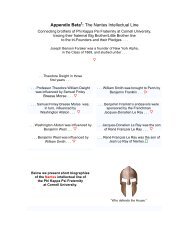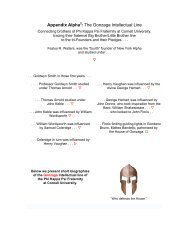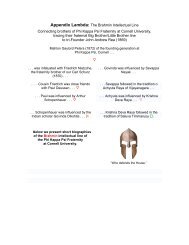Gondar - Phi Kappa Psi
Gondar - Phi Kappa Psi
Gondar - Phi Kappa Psi
Create successful ePaper yourself
Turn your PDF publications into a flip-book with our unique Google optimized e-Paper software.
formerly occupied by a large community of native nuns --the only female religious<br />
in Goa; the Augustinian church and convent built in 1572, now in ruins; convent<br />
and church of St. John of God (1685), now partly in ruins; the Rosary church of<br />
the Dominicans, built before 1543; the viceregal chapel of St. Anthony, of about<br />
the same date. The last two were still in full repair at the turn of the nineteenth<br />
century.<br />
To the south are the ruins of the Jesuit college of St. Paul, built about<br />
1541, and the Carmelite church and convent, built about 1612, occupied after<br />
1707 by Oratorians. The chapel of St. Francis Xavier, the scene of the "Domine,<br />
satis est", built before 1542, is still in repair. The following either have entirely<br />
disappeared or their sites are marked only by ruins: the chapel of St. Martin, built<br />
shortly after 1547; college and church of St. Bonaventure (about 1602); Nossa<br />
Senhora de Serra (1513); convent and church of St. Dominic, built about 1548,<br />
rebuilt 1550, Santa Luzia at Daujim (about 1544); church of St. Thomas, built to<br />
receive the relics of St. Thomas brought from Mylapore in 1560; church of St.<br />
Alexis, built before 1600; church of the Holy Trinity, built about the same time;<br />
convent and church of Cruz dos Milagres, built after 1619; Nossa Senhora da<br />
Luz built before 1543; new college and church of St. Paul (alias convent of St.<br />
Roch) used as a college in 1610, church rebuilt later. From the church of Our<br />
Lady of the Mount, on the eastern hill, which is still in repair, a magnificent<br />
panorama is obtained.<br />
As for Francis Xavier, he was born in the Castle of Xavier near Sanguesa,<br />
in Navarre, 7 April, 1506; died on the Island of Sancian near the coast of China, 2<br />
December, 1552. In 1525, having completed a preliminary course of studies in<br />
his own country, Francis Xavier went to Paris, where he entered the collège de<br />
Sainte-Barbe. Here he met the Savoyard, Pierre Favre, and a warm personal<br />
friendship sprang up between them. It was at this same college that St. Ignatius<br />
Loyola, who was already planning the foundation of the Society of Jesus, resided<br />
for a time as a guest in 1529. He soon won the confidence of the two young men;<br />
first Favre and later Xavier offered themselves with him in the formation of the<br />
Society. Four others, Lainez, Salmerón, Rodríguez, and Bobadilla, having joined<br />
them, the seven made the famous vow of Montmartre, 15 Aug., 1534.<br />
After completing his studies in Paris and filling the post of teacher there for<br />
some time, Xavier left the city with his companions 15 November, 1536, and<br />
turned his steps to Venice, where he displayed zeal and charity in attending the<br />
sick in the hospitals. On 24 June, 1537, he received Holy orders with St. Ignatius.<br />
The following year he went to Rome, and after doing apostolic work there for<br />
some months, during the spring of 1539 he took part in the conferences which St.<br />
Ignatius held with his companions to prepare for the definitive foundation of the<br />
Society of Jesus. The order was approved verbally 3 September, and before the<br />
written approbation was secured, which was not until a year later, Xavier was<br />
appointed, at the earnest solicitation of the John III, King of Portugal, to<br />
evangelize the people of the East Indies. He left Rome 16 March, 1540, and






